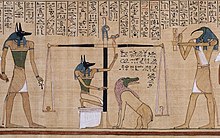
Back المعتقدات المصرية القديمة بالحياة الآخرة Arabic প্রাচীন মিশরীয় পরকালতত্ত্ব Bengali/Bangla Jenseits (Altes Ägypten) German Αρχαίες αιγυπτιακές πεποιθήσεις για τη μεταθανάτια ζωή Greek Antiguas creencias egipcias del más allá Spanish باورهای زندگی پس از مرگ مصر باستان Persian Au-delà (Égypte antique) French Հին եգիպտացիների համոզմունքներն անդրշիրիմյան կյանքի մասին Armenian Kepercayaan akhirat Mesir Purba Malay

| Part of a series on |
| Ancient Egyptian religion |
|---|
 |
|
|
Ancient Egyptian afterlife beliefs were centered around a variety of complex rituals that were influenced by many aspects of Egyptian culture. Religion was a major contributor, since it was an important social practice that bound all Egyptians together. For instance, many of the Egyptian gods played roles in guiding the souls of the dead through the afterlife. With the evolution of writing, religious ideals were recorded and quickly spread throughout the Egyptian community. The solidification and commencement of these doctrines were formed in the creation of afterlife texts which illustrated and explained what the dead would need to know in order to complete the journey safely.
Egyptian religious doctrines included three afterlife ideologies: belief in an underworld, eternal life, and rebirth of the soul. The underworld, also known as the Duat, had only one entrance that could be reached by traveling through the tomb of the deceased. The initial image a soul would be presented with upon entering this realm was a corridor lined with an array of fascinating statues, including a variation of the hawk-headed god, Horus. The path taken to the underworld may have varied between kings and common people. After entry, spirits were presented to another prominent god, Osiris. Osiris would determine the virtue of the deceased's soul and grant those deemed deserving a peaceful afterlife. The Egyptian concept of 'eternal life' was often seen as being reborn indefinitely. Therefore, the souls who had lived their life elegantly were guided to Osiris to be born again.[2]
In order to achieve the ideal afterlife, many practices had to be performed during one's life. This may have included acting justly and following the beliefs of the Egyptian creed. Additionally, the Egyptians stressed the rituals completed after an individual's life has ended. In other words, it was the responsibility of the living to carry out the final traditions required so the dead could promptly meet their final fate. Ultimately, maintaining high religious morals by both the living and the dead, as well as complying to a variety of traditions, guaranteed the deceased a smoother transition into the underworld.
Egyptians hoped to perform their jobs and partake in their hobbies in the afterlife.[3] Rivers and natural locales with fertile soil for farmers were thought to exist in the afterlife, and drawings on tomb walls of objects such as boats were thought to make them appear in the afterlife for previous users or owners.[3]
- ^ "Egyptian Book of the Dead". Egyptartsite.com. Archived from the original on 2012-09-26. Retrieved 2012-08-18.
- ^ Mojsov, Bojana (2001). "The Ancient Egyptian Underworld in the Tomb of Sety I: Sacred Books of Eternal Life". The Massachusetts Review. 42 (4): 489–506. JSTOR 25091798.
- ^ a b Williams, Ann R., ed. (2022). Treasures of Egypt: A Legacy In Photographs from the Pyramids to Cleopatra. Foreword by Fredrik Hiebert. Washington, D.C.: National Geographic. p. 109. ISBN 978-1-4262-2263-4.